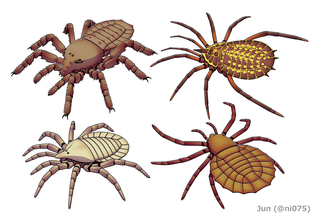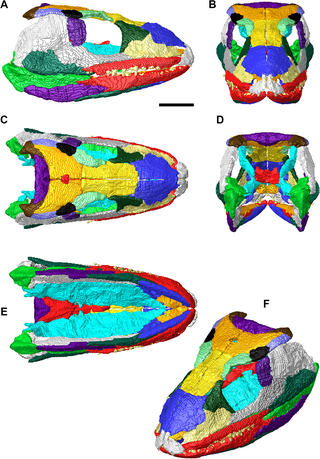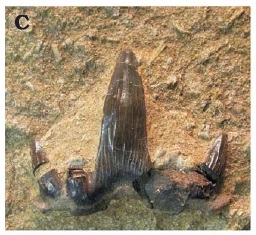
The Carboniferous is a geologic period and system of the Paleozoic that spans 60 million years from the end of the Devonian Period 358.9 Ma to the beginning of the Permian Period, 298.9 Ma. In North America, the Carboniferous is often treated as two separate geological periods, the earlier Mississippian and the later Pennsylvanian.

Dumfriesshire or the County of Dumfries or Shire of Dumfries is a historic county and registration county in southern Scotland. The Dumfries lieutenancy area covers a similar area to the historic county.
Romer's gap is an apparent gap in the Paleozoic tetrapod fossil record used in the study of evolutionary biology, which represent periods from which excavators have not yet found relevant fossils. It is named after American paleontologist Alfred Romer, who first recognised it in 1956. Recent discoveries in Scotland are beginning to close this gap in palaeontological knowledge.
Lethiscus is the earliest known representative of the Aistopoda, a group of very specialised snake-like tetrapodomorphs known from the early Carboniferous (Mississippian).

Carboniferous Limestone is a collective term for the succession of limestones occurring widely throughout Great Britain and Ireland that were deposited during the Dinantian Epoch of the Carboniferous Period. These rocks formed between 363 and 325 million years ago. Within England and Wales, the entire limestone succession, which includes subordinate mudstones and some thin sandstones, is known as the Carboniferous Limestone Supergroup.

The order Trigonotarbida is a group of extinct arachnids whose fossil record extends from the late Silurian to the early Permian. These animals are known from several localities in Europe and North America, as well as a single record from Argentina. Trigonotarbids can be envisaged as spider-like arachnids, but without silk-producing spinnerets. They ranged in size from a few millimetres to a few centimetres in body length and had segmented abdomens (opisthosoma), with the dorsal exoskeleton (tergites) across the backs of the animals' abdomens, which were characteristically divided into three or five separate plates. Probably living as predators on other arthropods, some later trigonotarbid species were quite heavily armoured and protected themselves with spines and tubercles. About seventy species are currently known, with most fossils originating from the Carboniferous coal measures.

Anthracosaurus is an extinct genus of embolomere that lived during the Late Carboniferous in what is now Scotland, England, and Ohio. Measuring around 10 ft (3.0 m) long, it was a large, aquatic eel-like predator. It has a robust skull about 40 centimetres (1.3 ft) in length with large teeth in the jaws and on the roof of the mouth. Anthracosaurus probably inhabited swamps, rivers and lakes. Its name is Greek for "coal lizard".

Pederpes is an extinct genus of early Carboniferous tetrapod, dating from 348 to 347.6 Ma in the Tournaisian age. Pederpes contains one species, P. finneyae, 1 m long.

Eoherpeton is the only genus of the family Eoherpetontidae in the extinct suborder Embolomeri. It is known from the Visean and Namurian stages of the Carboniferous of Scotland.

Strepsodus is a genus of rhizodont lobe-finned fish that lived throughout the Carboniferous period. Fossils have been found in eastern Canada, Britain, and Queensland, Australia; indeterminate species of Strepsodus have also been found in the late Devonian deposits of Turkey, Iran and Colombia. A large individual is measured up to 3.5 metres (11.5 ft) long.

Glikmanius is an extinct genus of ctenacanth cartilaginous fish which lived in the Carboniferous of North America and Russia. The genus is based on a whole specimen from Nebraska, USA. Glikmanius is named in honour of the Russian palaeontologist, Dr. Leonid Glikman, who studied the genus and was "the first to propose its ctenacanthiform affinity". G. careforum may have reached lengths of 3 metres (9.8 ft), while G. occidentalis may have reached lengths of over 6 metres (20 ft), making it one the largest marine predators of its era.

Dendrerpetontidae is a family of basal temnospondyls that lived during the Carboniferous period.
Doragnathus is an extinct genus of stem-tetrapod from the Early Carboniferous of Scotland.
Cladodus is an extinct genus of cartilaginous fishes in the family Ctenacanthidae. As the name implies, they are a type of cladodont, primitive sharks with teeth designed to snag fish and swallow them whole, instead of sawing off chunks to swallow.

Ctenacanthus is an extinct genus of ctenacanthiform chondrichthyan. Remains have been found in the Bloyd Formation of Arkansas and the Cleveland Shale of Ohio in the United States and in South America.
Acondylacanthus is an extinct genus of ctenacanthiform from the Paleozoic era. The type species is A.gracilis. Most species are known from the Carboniferous of America and the British isles. A. jaekeli is known from the upper Frasnian of Germany and the Upper Famennian of Russia. This genus is based entirely upon isolated dorsal fin spines, and thus may later be found synonymous with tooth-based genera. Many species have been ascribed to this genus, though there has been some confusion with Ctenachanthus. This genus is in need of review and research.

Ctenacanthiformes is an extinct order of cartilaginous fish. They possessed ornamented fin spines at the front of their dorsal fins and cladodont-type dentition, that is typically of a grasping morphology, though some taxa developed cutting and gouging tooth morphologies. Some ctenacanths are thought to have reached sizes comparable to the great white shark, with body lengths of up to 7 metres (23 ft) and weights of 1,500–2,500 kilograms (3,300–5,500 lb). The earliest ctenacanths appeared during the Frasnian stage of the Late Devonian, with the group reaching their greatest diversity during the Early Carboniferous (Mississippian), and continued to exist into at least the Middle Permian (Guadalupian). Some authors have suggested members of the family Ctenacanthidae may have survived into the Cretaceous based on teeth found in deep water deposits of Valanginian age in France and Austria, however, other authors contend that the similarity of these teeth to Paleozoic ctenacanths is only superficial, and they likely belong to neoselachians instead.
Papposaurus is an extinct genus of proterogyrinid embolomere which lived in the Mississippian of Scotland. It is known from a single species, Papposaurus traquiairi, which is based on an isolated femur discovered in ironstone near Loanhead. Though originally compared closely to reptiles, subsequent study has revealed closer similarity to basal embolomeres such as Proterogyrinus and Archeria. With such limited remains, Papposaurus may not be a valid genus. The femur was redescribed in 1986 by T. R. Smithson, who considered Papposaurus traquairi a nomen vanum possibly synonymous with Proterogyrinus scheelei.

Dracopristis is an extinct genus of ctenacanth that lived around 307 million years ago, during the Pennsylvanian sub-period of the Carboniferous period. The fish had 12 rows of short, squat teeth, and an array of spines on its dorsal fins. The main differentiation between ctenacanthiformes and true sharks is that ctenacanthiform mouths are larger but less flexible than the true sharks. The spines of the holotype fossil are about 0.57 meters long, and the whole body was around 2 meters (6 ft) long.
Saivodus is an extinct genus of ctenacanthiform fish that existed in early Mississippian of the Carboniferous period. Fossils have been found in Ireland, Scotland, England, Belgium, Morocco, and the United States. Teeth assigned to that genus are also known from the Permian (Leonardian) Kaibab Formation.


















